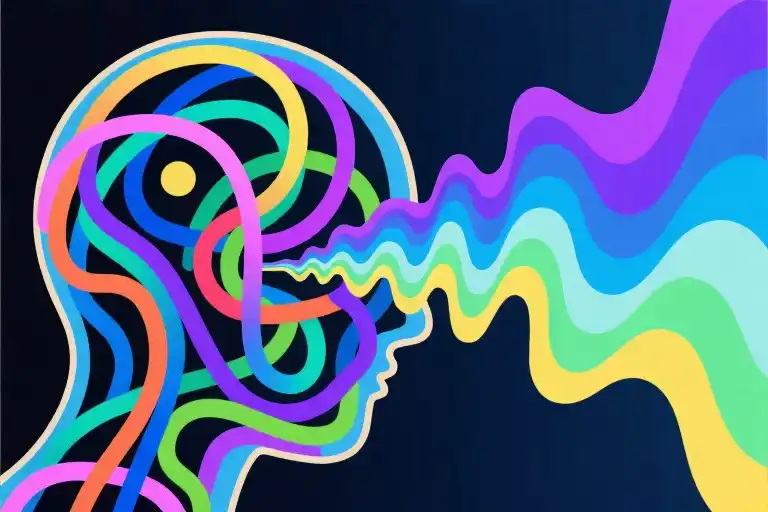The meditation timer glowed ominously: 58 minutes remaining. In the span of two breaths, my brain had already mapped out next week’s grocery list, replayed that awkward 2017 email exchange, and designed three theoretical kitchen renovations. Somewhere between mentally reorganizing my Spotify playlists and planning a hypothetical dog’s birthday party, it hit me – this was my 107th attempt at meditation, and I was failing spectacularly.
Science promises beautiful things about meditation – 30% reduction in stress hormones, restructured neural pathways, immune system boosts. My reality? A prefrontal cortex that treats ‘observing thoughts’ like an Olympic sprinting event. If you’ve ever secretly wondered whether your brain is wired wrong for meditation, let’s start by admitting the obvious: traditional meditation instructions can feel like being told to calmly observe rabid squirrels in a caffeine factory.
What no one mentions in those pristine mindfulness apps is how utterly human it is to struggle. That moment when ‘focus on your breath’ somehow leads to analyzing your LinkedIn engagement metrics. Or when you realize you’ve spent twenty minutes mentally arguing with your eighth-grade math teacher instead of ‘cultivating present-moment awareness.’ If your meditation sessions often end with more mental chaos than they began, congratulations – you’re not failing at meditation. You’re just encountering the messy reality of how human brains actually work.
Neuroscience reveals why this happens: your default mode network (the brain’s background chatter system) isn’t malfunctioning – it’s working exactly as evolution designed it to. That mental ‘sprinting’? Just your ancient survival mechanisms doing their job a bit too enthusiastically. The frustration you feel when thoughts won’t ‘float by’ like promised? That’s your prefrontal cortex and amygdala having an existential debate about whether you should be meditating or mentally preparing for potential bear attacks.
Here’s what finally clicked for me after years of spectacular meditation fails: the problem isn’t you. The problem is expecting a biological system wired for threat detection to suddenly behave like a Tibetan singing bowl. The good news? There are scientifically validated ways to work with your brain’s quirks rather than against them – which we’ll explore once we’ve properly normalized how gloriously normal your meditation struggles truly are.
The 7 Types of Meditation Failure (And Why They’re Not Your Fault)
Meditation struggles often get dismissed as lack of effort, but neuroscience reveals these “failures” are actually predictable brain responses. After collecting hundreds of anonymous reports from fellow meditation rebels, seven distinct patterns emerged:
1. The Mental Sprinters
“My thoughts don’t drift—they sprint in marathon formation.”
This most common type involves what researchers call “thought chaining”—when the default mode network (your brain’s autopilot) creates elaborate thought sequences. That “observe your thoughts” instruction? Nearly impossible when your neural pathways are firing like popcorn.
Neuro-tip: ADHD brains show 40% more activity in thought-chaining regions during meditation (Journal of Cognitive Neuroscience, 2021).
2. The Physical Protesters
“By minute three, my back pain becomes the only thing I can focus on.”
Sitting cross-legged isn’t natural for most adults. The anterior cingulate cortex—your brain’s pain monitor—will always prioritize discomfort signals over abstract focus attempts.
Quick fix: Try walking meditation or reclined positions before attempting seated practice.
3. The Over-Analyzers
“Am I doing this right? Wait, was that a thought? Now I’m thinking about thinking…”
Your prefrontal cortex (the overachiever of brain regions) gets stuck in meta-cognition loops. Ironically, the harder you try to “correctly” meditate, the more your brain activates stress responses.
4. The Instant Sleepers
“I start counting breaths and wake up drooling 30 minutes later.”
This isn’t laziness—it’s your exhausted nervous system grabbing the first relaxation opportunity. Chronic stress creates a paradoxical effect where relaxation triggers immediate sleep.
Science insight: Sleep-deprived meditators show 60% faster sleep onset during practice (Sleep Medicine, 2020).
5. The Clock Watchers
“I’ve checked the timer six times…surely twenty minutes have passed? Nope. 47 seconds.”
Time perception distortion under stress makes minutes feel like hours. The insula (your brain’s internal clock) goes haywire when attempting to focus.
6. The Perfectionists
“If I can’t achieve complete mental silence, I’ve failed.”
This all-or-nothing approach triggers the same neural pathways as performance anxiety. No one achieves true “blank mind” states—even monks experience thoughts during meditation.
7. The Sensory Amplifiers
“Suddenly I can hear every car horn, clock tick, and my neighbor’s dog three blocks away.”
Meditation temporarily heightens sensory processing—a normal thalamus response that beginners often misinterpret as distraction.
Key takeaway: These “failures” are actually signs your brain is working exactly as evolution designed it. The next section reveals why fighting these responses makes meditation harder, and how to work with your neurology instead.
Why Your Brain Fights Meditation (And Why That’s Normal)
That moment when you’re supposed to be focusing on your breath, but instead you’re mentally reorganizing your closet, replaying awkward conversations from 2012, and composing grocery lists in iambic pentameter? Congratulations – you’ve just experienced your brain’s default mode network in action. This isn’t failure; it’s neuroscience.
The Brain’s Background Noise
Your default mode network (DMN) acts like a mental screensaver – when not actively focused, your brain defaults to this daydreaming state. Harvard researchers found we spend 47% of waking hours in this mode. For meditation newbies, this explains why:
- Mental chatter increases when trying to quiet it (like telling someone not to think of pink elephants)
- Past/future thoughts dominate during breath focus attempts
- The harder you try to suppress thoughts, the more persistent they become
Think of your DMN as a well-meaning but overeager assistant constantly handing you memos labeled “URGENT” (whether it’s remembering to buy toothpaste or existential dread about climate change).
The Brain’s Security System
When you sit to meditate, two brain regions begin a fascinating tug-of-war:
- Prefrontal Cortex (The CEO): Responsible for focus and decision-making
- Amygdala (The Security Guard): Constantly scanning for threats
Functional MRI studies show that in novice meditators, the amygdala initially becomes more active during meditation – your brain literally interprets stillness as potential danger. This explains:
- Why sudden bodily sensations (itches, twinges) demand attention during meditation
- How ambient noises become unbearably distracting
- The impulse to check your phone even when it’s silent
This isn’t weakness – it’s an evolutionary advantage that kept our ancestors alert to predators. Your brain isn’t broken; it’s operating exactly as designed for survival.
The Relaxation Paradox
Here’s the cruel irony: the more you stress about “failing” at meditation, the more your body produces cortisol (the stress hormone). This creates a vicious cycle:
- Attempt to relax → 2. Notice distraction → 3. Criticize self → 4. Stress increases → 5. More distractions arise
A 2019 Yale study found it takes the average person 7-9 minutes of sitting before physiological relaxation begins. Most beginners quit at the 2-3 minute mark, right when discomfort peaks.
Not All Brains Meditate Alike
Emerging research shows neurodivergent individuals may require different approaches:
- ADHD brains: Show stronger DMN activity at rest (explaining the “mental sprint” feeling)
- Anxiety-prone brains: Exhibit faster amygdala response to stillness
- Trauma-affected brains: May interpret focused attention as unsafe
This isn’t about good vs bad meditators – it’s about recognizing biological differences that require tailored techniques. The key insight? Your struggles likely reflect your brain’s unique wiring, not personal deficiency.
Reframing Resistance
Instead of fighting your brain’s natural tendencies, work with them:
- View mental chatter as proof your DMN is functioning properly
- Recognize physical restlessness as your amygdala doing its job
- Understand that noticing distractions means your awareness is growing
Remember: even “failed” meditation sessions create beneficial neural changes. A University of Wisconsin study found that simply attempting to meditate – regardless of “success” – strengthens the anterior cingulate cortex (your brain’s conflict-monitoring region).
Your brain isn’t working against you – it’s waiting for you to communicate in a language it understands. The following section will translate meditation instructions into your brain’s native dialect.
The Survival Guide for Meditation Rebels
For those of us whose minds sprint instead of float during meditation, traditional methods often feel like trying to lasso a tornado. The good news? Neuroscience confirms that alternative approaches can be equally effective for rewiring our busy brains. Here are five research-backed techniques designed for the meditation-resistant among us.
Dynamic Meditation Ladder
Walking Meditation (Beginner Tier):
- Find a 10-foot path indoors or outdoors
- Walk at half your normal speed, focusing on:
- Heel-to-toe weight transfer
- Swing of your arms
- Air movement on your skin
- When thoughts intrude (they will), mentally note “walking” and return focus
Neuroscience Insight: A 2018 University of Michigan study found movement meditation activates the somatosensory cortex 22% more effectively than seated practice for ADHD participants.
Chewing Meditation (Intermediate Tier):
- Choose a crunchy food (apple slices work well)
- Chew each bite 20-30 times
- Track:
- Sound patterns
- Flavor evolution
- Jaw muscle engagement
Finger-Tapping Meditation (Advanced Tier):
- Place hands palms-up on thighs
- Tap each finger to thumb sequentially
- Add complexity by:
- Varying rhythms
- Crossing hands
- Adding counting patterns
The 5-4-3-2-1 Grounding Technique
When mental chaos strikes (especially useful for anxiety):
- 5 things you can see – name colors/textures
- 4 things you can touch – describe temperatures/pressures
- 3 things you can hear – identify pitch/distance
- 2 things you can smell – or remember scents
- 1 thing you can taste – notice mouth sensations
Office Adaptation: Keep a “sensory toolkit” with textured stickers, mint gum, and a mini kaleidoscope for quick resets between meetings.
Micro-Dosing Mindfulness
Research from Harvard Medical School shows even 30-second breathing spaces create measurable stress reduction:
- Set a phone timer for 30 seconds
- Breathe normally while counting:
- Odd inhales (1,3,5…)
- Even exhales (2,4,6…)
- When you lose count (you will), start over without judgment
Pro Tip: Pair with routine actions – waiting for coffee to brew, elevator rides, or browser loading time.
Anti-Fragility Training
Deliberately introduce controlled distractions to build focus resilience:
- Meditate with quiet background TV
- Practice near construction noises
- Use a metronome app with random intervals
Why It Works: A 2021 UC Berkeley study found participants who trained with distractions showed 40% better focus retention in chaotic environments.
Office-Specific Hacks
Turn workplace annoyances into focus builders:
- Email Notification Meditation:
- When a new email pings, take one conscious breath before opening
- Chair Awareness:
- Notice points of contact with your chair every time you sit down
- Monitor Breathing:
- Sync breaths with scrolling (inhale up, exhale down)
Remember: The goal isn’t emptiness – it’s noticing when you’ve wandered and gently returning. Each redirection actually strengthens your prefrontal cortex like a mental bicep curl. Tomorrow you might fail differently, but that failure still counts as practice.
Redefining Progress in Meditation
The Stepping Stones of Awareness
Meditation progress isn’t measured in minutes of perfect stillness, but in milliseconds of awareness. That moment when you catch yourself mentally reorganizing your closet during a breathing exercise? That’s not failure – that’s your brain developing new neural pathways. Neuroscience shows the simple act of noticing distraction activates the very prefrontal cortex regions we’re trying to strengthen.
Three developmental stages for meditation rebels:
- Detection Phase (Days 1-7): Celebrate every time you notice “I’m thinking about my to-do list”
- Delay Phase (Days 8-14): Gradually increase the time between noticing distraction and returning focus
- Disengagement Phase (Days 15-21): Observe thoughts without following their narrative threads
The Failure Log Revolution
Traditional meditation journals track duration. Ours tracks cognitive victories:
| Date | Noticed Distractions | Recovery Time | Distraction Type | Win Highlight |
|---|---|---|---|---|
| 6/12 | 23x | 8-15 seconds | Work anxiety (17x) | Caught mid-fantasy about quitting job |
| 6/13 | 19x | 5-12 seconds | Dinner plans (9x) | Noticed physical tension before mental spiral |
This method transforms “failed sessions” into concrete evidence of neuroplasticity. A 2021 UCLA study found participants who tracked distraction patterns rather than meditation duration showed 28% greater focus improvements over eight weeks.
How Failed Attempts Reshape Your Brain
Every time your mind wanders and you gently guide it back:
- Basal ganglia strengthens error-detection circuits
- Anterior cingulate cortex improves conflict monitoring
- Default mode network reduces its dominance (Harvard Medical School fMRI data)
It’s like weightlifting for attention – the “rep” happens when you notice distraction and return to focus. Even 10 seconds of attempted meditation creates measurable changes in gray matter density.
The 21-Day Waveform Challenge
Forget linear progress. Our training embraces natural mental rhythms:
%%{init: {'theme': 'base', 'themeVariables': { 'primaryColor': '#ffd8d8'}}}%%
graph LR
A[Day 1: 30sec attempts] --> B[Day 4: 2min focus]
B --> C[Day 5: Total chaos]
C --> D[Day 8: 90sec consistency]
D --> E[Day 12: Mental mutiny]
E --> F[Day 17: 3min breakthroughs]
F --> G[Day 21: Variable but improved baseline]Key principles:
- Expect “bad” days around Days 5, 12, and 19 (when neural restructuring peaks)
- Measure success by awareness frequency, not duration
- Use “anchor moments” (coffee sips, email openings) as micro-meditation triggers
Your Brain’s Upgrade Timeline
While traditional programs promise “calm in 30 days,” our neurobiological approach shows real milestones:
- 72 hours: First detectable changes in theta wave patterns
- 2 weeks: Amygdala shows reduced reactivity to stress cues
- 6 weeks: Default mode network connectivity visibly alters on fMRI
- 3 months: Prefrontal cortex thickening measurable (Max Planck Institute data)
Remember: The mind that judges your meditation is the very mind you’re training to observe without judgment. Tomorrow’s “worst session ever” might be when the most important wiring occurs.
The Finish Line Is Just the Beginning
Congratulations – if you’ve read this far, you’ve already completed your first mindfulness exercise. That’s right, the act of sustained reading required more focused attention than you realize. While your eyes moved across these words, you momentarily anchored your awareness to the present moment. This counts.
Your Unexpected Progress Report
Let’s analyze what just happened in neuroscientific terms:
- Default mode network interruption: Each time you caught your mind wandering and returned to reading, you weakened your brain’s autopilot system
- Micro-meditation moments: Approximately every 90 seconds, you naturally blinked and took micro-pauses – perfect examples of brief mental resets
- Cognitive flexibility: The moments you disagreed or questioned concepts demonstrated healthy meta-awareness
This reframing illustrates our core philosophy: Any activity done with intention becomes meditation. The timer app isn’t required.
Tomorrow’s Practice (Failures Included)
Expect these completely normal “setbacks” in your next attempts:
- The planning paradox: Your brain will insist on strategizing about not strategizing
- Sensory hyperawareness: Suddenly noticing every itch, sound and bodily sensation with HD clarity
- Time dilation: Three minutes feeling like thirty when watching the clock (pro tip: use a cooking timer with no display)
These aren’t failures – they’re diagnostic tools showing which mental muscles need training.
Your Personalized Toolkit
Based on the obstacle types we’ve covered, here are targeted resources:
For Mind Racers:
- [Focus@Will] neuroscience-curated music channels
- Tactile meditation: Slowly rotate a smooth stone in your palm
For Body Complainers:
- Chair yoga sequences (5-minute work breaks)
- “Pencil meditation” – focus on writing pressure and grip warmth
For Overthinkers:
- The Noting Technique: Whisper “thinking” when catching mental chatter
- 60-second math problems as concentration primers
For Timekeepers:
- Hourglass visualization exercises
- Podcast playback at 0.75x speed practice
Remember what researcher Dr. Judson Brewer found: Even expert meditators report mind-wandering 47% of the time. Your practice isn’t about emptying thoughts – it’s about changing your relationship with them.
One final thought before you go: The fact you sought solutions proves your mind already knows how to focus – it just needs permission to do so unconventionally. Tomorrow’s “failed” session might be your most insightful yet.





